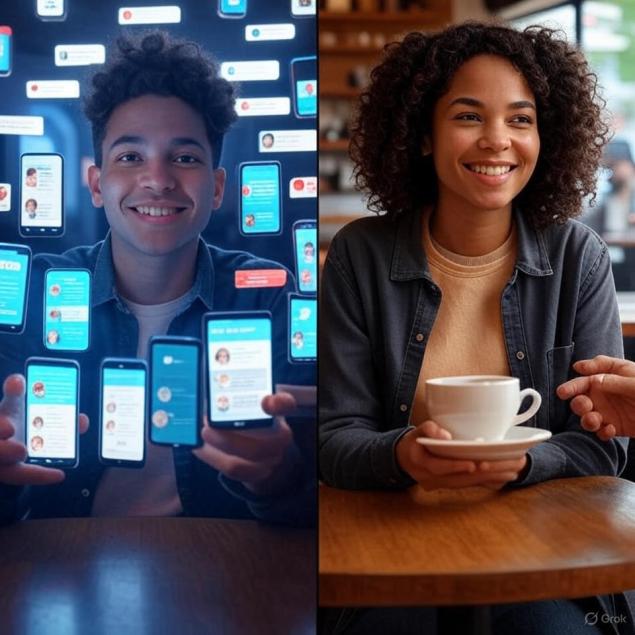96
10 Reasons Why You Can't Make Close Friends
485.76
In the digital age, the paradox of modern society is becoming increasingly apparent: with hundreds of virtual contacts, many experience a keen sense of loneliness in real life. Psychologists call it “social isolation in a hyper-connected world.” We will examine the underlying causes of this phenomenon and find ways to genuine intimacy.
The statistics are striking: According to research by the American Psychological Association, 35% of American adults report severe loneliness, with 61% of young adults aged 18-25 experiencing significant social isolation. In Russia, the figures are similar – every third resident of the metropolis feels lonely, despite an active social life on the Internet.
Psychological barriers to friendship
The syndrome of perfectionist expectations
Modern society creates unrealistic ideas about the ideal friendship. We are subconsciously looking for a person who will become a universal companion - will share all our interests, will always be available and will never disappoint. This is a classic example of cognitive distortion, which psychologists call the “excessive expectation effect.”
Lifehack: Create a “friendship map” – a list of 5-7 qualities that really matter to you in a friend. Requirements like “should love the same movies” or “never be late” are excluded. Focus on fundamental values: honesty, support, shared life principles.
Comfort Zone as a Psychological Prison
Neuroscientists have proven that our brains are designed to avoid uncertainty and novelty. Every time we refuse an invitation or avoid new acquaintances, we strengthen the neural connections that make social activity even more intimidating. This is a vicious cycle of social anxiety.
The 3 Minute Rule technique: When you get an invitation to an event, don’t say no. Give yourself 3 minutes to think about the potential benefits. Studies show that this time is enough for the prefrontal cortex to take control of the amygdala’s emotional responses.
Virtual pseudo-proximity
Social media creates the illusion of intimacy through the mechanism of “parasocial relationships” – a one-way emotional connection with people we know superficially. Dopamine surges from likes and comments mimic the pleasure of real communication, but do not provide a deep need for acceptance and understanding.
MIT social psychologist Sherry Turkle warns: We expect more from technology and less from each other. Digital connections may seem less risky, but they are also less rewarding.”

The wall of emotional inaccessibility
Fear of vulnerability is an evolutionary self-defense mechanism that often works against us in the modern world. Research in neuropsychology shows that the ability to be emotionally open is directly correlated with levels of oxytocin, the attachment hormone. The more we hide our true feelings, the harder it is for our brains to form deep social connections.
Exercise "Graded Openness": Start small by sharing a small personal story or experience with a colleague. Gradually increase your level of trust. This trains the neural pathways responsible for social intimacy.
Chronic employment syndrome
Modern society has created a cult of employment, creating the illusion that constant activity equals productivity and success. But time management research shows that people who consciously devote time to social interactions are more successful and happier in the long run.
Social Blocking Method: Book 2-3 hours a week exclusively for social activities. Treat this time as an important business meeting - do not postpone or cancel without serious reasons.
Passivity in social relationships
Many expect others to take the initiative without understanding the fundamental principle of social psychology: relationships require a mutual investment of energy. This is due to a cognitive bias known as the “false consensus effect” – we assume that others think and act the same way we do.
First contact rule: If you like talking to someone, send them a message within 24 hours. It could be a simple “It was nice to meet you” or a reference to something you discussed. The initiative creates a positive impetus for the development of relations.
Hyperselectivity as a protective mechanism
When we are overly selective in our choice of friends, it often masks our fear of rejection. Psychologists call this “preventive rejection” – we reject others before they can reject us. This strategy seems safe, but leads to social isolation.
Temporary Friendship Technique: Try to accept the idea that not all relationships should be forever. Some people come into our lives for a period of time, and that’s normal. Reducing pressure “forever” makes dating easier and more natural.
Nostalgic trap
Idealizing past relationships creates unrealistic standards for new dating. This phenomenon, known as pink memory glasses, prevents us from seeing potential in our current relationships. Neuroscientists explain this by the fact that the brain erases negative memories over time, leaving mostly positive ones.
Exercise "Realistic memory": Make an honest list of the pros and cons of past friendships. This will help to remove the plaque of idealization from them and open the heart to new people.
Inability to forgive and let go
Studies show that the ability to forgive is directly related to the quality of social relationships. People who hold resentments activate areas in the brain associated with stress and anxiety, which prevents the formation of new attachments. Forgiveness is not an excuse for someone else’s behavior, but a liberation from emotional shackles.
The “Emotional Inventory” technique: Review your grievances regularly. Ask yourself, “Does this hurt me?” Does it help me grow and develop? If the answer is no, it is time to let go.
Low self-esteem as a barrier
People with low self-esteem often project their fears onto others, suggesting they are "not interesting enough" for friendships. This creates a self-fulfilling prophecy: self-doubt is broadcast in behavior that can really alienate potential friends.
Evidence-gatherer method: Keep a journal of positive social interactions. Write down every time someone smiled, thanked, asked for advice. It trains the brain to notice evidence of your social worth.
611683
The Path to True Intimacy
Creating deep friendships is not magic, but a skill that can be developed. The main thing to understand is that friendship requires time, effort and, above all, sincerity. Start small, be patient with yourself and others, and remember that every person who now has a strong friendship once took the first insecure steps towards people.
Glossary of terms
A parasocial relationship is a one-sided emotional connection that a person feels toward a media person or social media acquaintance with whom there is no real interaction.
Cognitive distortion is a systematic error in thinking that affects decision-making and judgment, deflecting them from logic and rationality.
Oxytocin is a hormone produced in the hypothalamus and plays a key role in the formation of social connections, trust and empathy.
The amygdala is an amygdala structure in the brain responsible for processing emotions, especially fear and anxiety.
The prefrontal cortex is the area of the brain responsible for decision-making, planning, and impulse control.
A self-fulfilling prophecy is a psychological phenomenon in which a false definition of a situation causes a new behavior that makes the initially false representation true.
Social anxiety is a psychological condition characterized by excessive fear of social situations and negative evaluation by other people.
What happens if you give up social media for a month?
Women's Winter Shoes 2025: A Guide to Choosing Stylish and Warm Shoes























